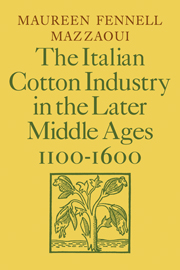Book contents
- Frontmatter
- Contents
- List of illustrations
- Preface
- List of abbreviations
- Map
- Introduction
- PART ONE THE ROLE OF COTTON IN THE MEDITERRANEAN ECONOMY
- PART TWO THE ORGANIZATION OF THE NORTH-ITALIAN INDUSTRY
- 3 The spread of cotton manufacture
- 4 Technological innovation
- 5 The structure of demand: products and markets
- 6 Guild and entrepreneurial structures
- PART THREE THE GROWTH OF COTTON MANUFACTURE NORTH OF THE ALPS
- APPENDICES
- Notes
- Select bibliography
- Index
4 - Technological innovation
Published online by Cambridge University Press: 05 March 2012
- Frontmatter
- Contents
- List of illustrations
- Preface
- List of abbreviations
- Map
- Introduction
- PART ONE THE ROLE OF COTTON IN THE MEDITERRANEAN ECONOMY
- PART TWO THE ORGANIZATION OF THE NORTH-ITALIAN INDUSTRY
- 3 The spread of cotton manufacture
- 4 Technological innovation
- 5 The structure of demand: products and markets
- 6 Guild and entrepreneurial structures
- PART THREE THE GROWTH OF COTTON MANUFACTURE NORTH OF THE ALPS
- APPENDICES
- Notes
- Select bibliography
- Index
Summary
The transplantation of an industry such as cotton manufacture across political, cultural and linguistic frontiers is part of a broader process of technological transmission. This aspect of medieval economic history has been relatively unexplored despite its obvious significance in the total picture of Islamic–Western relations from the late eleventh century on. The present lack of systematic research on the technology of Near Eastern manufacturing makes it difficult to chart with accuracy the spread of individual tools or techniques across Asia toward Europe. The difficulties are compounded when attempts are made to estimate the date when a single implement or a modified version of it was adopted by one branch or by the entire textile industry in any part of Europe. Our discussion here shall be limited to technological changes in cotton manufacture which are known to have been introduced in Europe through contacts with Islam in the eleventh and twelfth centuries, whatever their ultimate origin and channel of adoption, which remain highly speculative.
Technological change, in addition to the complex and still unsolved problems of chronology and modes of dissemination, raises also the fundamental question of receptivity. Meaningful change requires not merely technical know-how, but the willingness to experiment and to adapt implements developed elsewhere to the requisites of existing forms of production in the place of adoption.
- Type
- Chapter
- Information
- Publisher: Cambridge University PressPrint publication year: 1981



